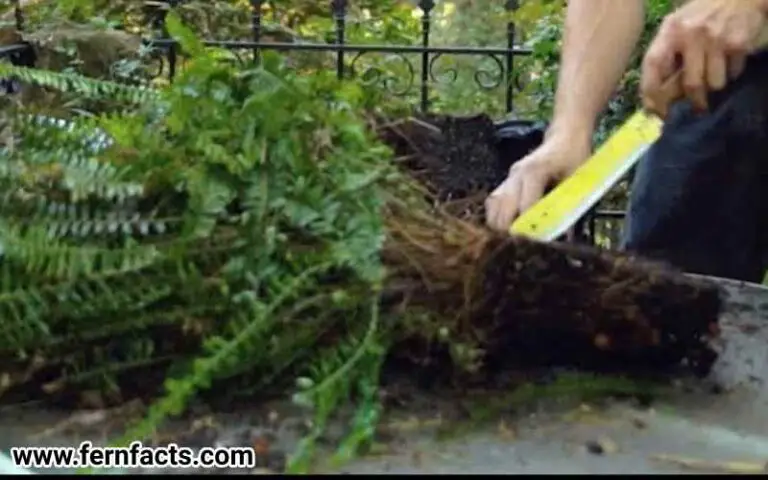What to Do With Boston Ferns in Winter
Every Boston fern plant gardener has faced the annual hassle and tiredness of maintaining these ferns in the winter seasons.
As these ferns are already dormant during these seasons, therefore they need a little extra care and supervision to survive in winter.
So if you are a new gardener of Boston Fern, and don’t have any idea how to care and revive for your Boston ferns in winter; then don’t worry!
This article will provide you with some comprehensive guidelines regarding Boston ferns overwinter care. Therefore, in this article, I’ll give a general overview of these Boston ferns along with their overwinter caring tips, accessories to have in those seasons, and the benefits of overwintering.
So let’s explore the topic more deeply.
Overview of Boston Fern

- Botanical name: Nephrolepis exaltata
- Common names: sword fern, bluebell Fern, tuber ladder Fern, Fishbone Fern
- Plants: Evergreen
- Native range: America
- Native habitats: moist shady locations like humid forests, swamps, and floodplains
- Shade requirements: partial shade or full shade
- Height: 20 to 98 inches
- Soil: acidic soil (6.0 to 6.5), moist well-drained, drought tolerant
Boston Fern is also known as sword fern blue bell Fern, tuber ladder Fern, or fishbone Fern in many regional countries.
They can grow to an average height of around 40 to 60 centimeters. However, in extreme cases, they can grow up to 1.5 meters in. They like moist shady places for their natural habitats.
Nonetheless, their soil can also tolerate drought. Still, you need to mist these plants if the humidity drops below 80%.
What to Do With Boston Fern in Winter?
Boston ferns are sensitive during winter seasons. So you need to bear a little extra care and maintenance regarding these ferns.
These plants prefer cool night atmospheric temperatures with lots of brightness. Similarly, for day temperature, these ferns prefer below 75°F or 24° C not over than these.
And so, high humidity is also one of the key factors in keeping these ferns as houseplants. If you live in hot and dry environments, overwintering care must cause you an abundance of work and frustration as these times Boston ferns need some extra care.
If you don’t have the appropriate place for approval indoors for your ferns, the young can keep them in the garage, basement, or outdoor building where the temperature usually remains around 55°F.
As these ferns become dormant in winter seasons, that’s why their growth becomes slower. At that time, you need to water them only once a month, not more than that.
Overwinter Care for Boston Ferns
During winter seasons the prior concern should make the plants survive, not thrive. So, make sure you don’t use any other seasonal care to make these ferns thrive and bloom in winter.
In the winter seasons, they need less water as their dormancy period starts. So, you need to do some extra care to save your plants from an overwintering situation.
Bring Your Plants Inside
If you’re growing your Boston ferns outside of the house, try to bring them inside your house before the winter season.
Before relocating them in your house, make sure you spray water on your plants so that any diseases, pests, or bugs fall from the fronds.
Later on, leave your plants under the sunlight for a day to two days so that your plants get dry completely. After the spraying and drying process, you can bring your plants inside your house.
Pruning the Plants
Similarly, If you tend to houseplant your Boston fern, then you need to remove any kind of brown, dead, or damaged black fronds so that they will be less targeted by any pests or other problems.
Also, cut off any bigger fronds compared to average growth and the size of the plants. Then you can generally shake your plants to shuffle all the excess fronds and foliage.
Relocate Your Ferns
You also need to relocate your ferns wisely
Try to choose a cool and moderately warm place around 60 to 75°F. These types of places will help your ferns to keep warm even in the cooler atmosphere.
Places like garage and basement would be one of the suggested ideas for you to apply on. Try to keep your ferns away from the window, especially south-facing windows during winter seasons.
It can scorch your plant’s fronds as well. To get even more humidity, you can combine the plants in groups which will promote humidity in the environment.
Water and Fertilizer
Try to remember, that you should not water these ferns regularly just like you do. You need to lessen the watering as it’s their dormant stage and they need less water. You can water them when the soil completely dries out.
You can either use a finger or thumb check-up method or you choose a moisture meter to measure the moisture in the soil. Additionally, you also need to avoid fertilizer during this stage. It might harm your plants as this time their growth stops.
So they don’t need any feed to grow abruptly. Let the winter pass gradually, just water them once a month that will be enough for that season.
What You Will Need in Winter to Care for Boston Ferns
Hand pruners
The first one is hand pruners. Few pruning tools and equipment are necessary for you to have winter seasons. These garden hand scissors must-have tools for you to have to utterly cut off the fronds and other timing methods.
Garden hose with a spray nozzle
Another tool is a garden hose with a spray nozzle. These spray nozzles are another important tool that you need to spray water on your ferns. You can have these in 50-foot lengths of size as well.
humid tray
Boston ferns are fond of humid conditions therefore a humid tray is another best option for you to have. You can fill the tray with water, and even pebbles which will humid the atmosphere around you into ferns. It’s usually an affordable and very efficient product to have as a gardener which will lessen the work.
Watering Can
You can also buy a watering can for your garden. As these Boston ferns don’t need much water in winter, however, they will need some to some extent but not as much as in their growing seasons. So, an ideal type of watering can is well-balanced and designed with a narrow spout. This will help to pour unnecessary water on your plants in the winter seasons.

Benefits of Overwintering
You’ll find lots of benefits and advantages of overwintering care. Let’s see those reasons
Less Costing
Some Plants are quite expensive and some plants are affordable to cheap. But changing dead plants every year during the perennial times, it’s not very easy to alternate the plants with new plants. Sometimes it might give you budget issues. Therefore, by overwintering you can renew perennial plants year after year.
Elegant greenery
Boston ferns don’t look best during the winter seasons although you can manage them to survive throughout the winter. If you follow the above guidelines properly, you’ll see an abundance of changes in the next spring seasons. Your ferns will bloom and thrive in nature with their greenery foliage which will completely change the look of your garden.
Longevity
Like Boston ferns, winter could be a hard time to deal with for many plants. If those plants are not cared for and maintained properly they will not survive in those harsh winter seasons. Ultimately, your plants will die. Therefore, overwinter care helps these types of ferns to remain all year round and develop their Longevity as well.
Conclusion
In conclusion, these Boston ferns process slow growth with lots of other problems like brown forms, and dead fronds. If you’re living in a frozen country, then these overwinter caring tips and guidelines will lead you to save your ferns from the excessively cold atmosphere. By following those steps, you can make your winter sad-looking ferns survive throughout the winter season which will lead you to thriving greenery foliage ferns in the spring season.







